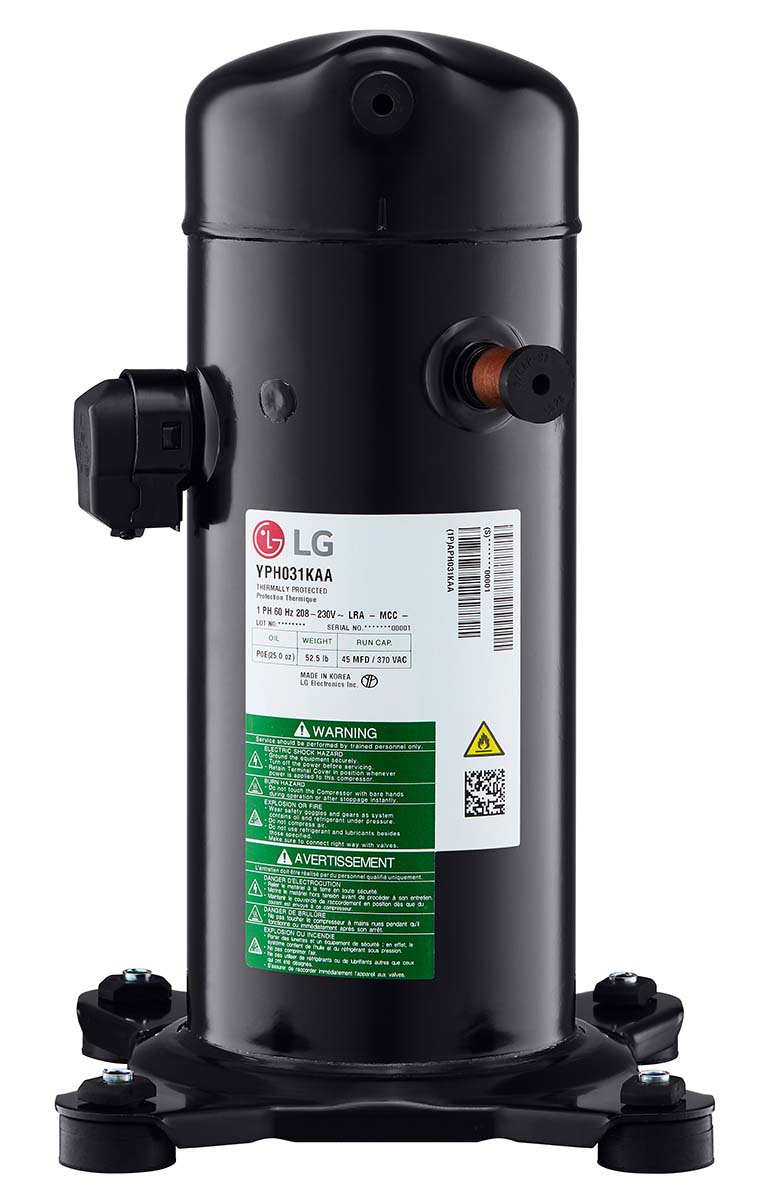OEMs, distributors, contractors, and technicians all have their eyes on December 31.
That’s the date, per U.S. Environmental Protection Agency (EPA) regulations, after which newly manufactured or imported residential heat pumps and a/c equipment must be built to use refrigerants with a GWP of no more than 700. Refrigerants with higher levels of hydrofluorocarbons (HFCs) and thus higher GWPs, such as R-410A (a 2,088 GWP), are being phased out in favor of A2L refrigerants such as R-32 (a 675 GWP) and R-454B (466).
(There is a year-long sell-through period: Equipment for higher-GWP refrigerants, like R-410A, that was made or imported this year or earlier can be sold through 2025.)
The refrigerant transition requires major changes in a component at the heart of a/c and heat pump systems — the compressor. Manufacturers say they’re on it.
“For several years, we’ve been supporting OEMs in preparing to launch A2L-optimized systems,” said Reema Kamat, director of product management and strategic marketing at Copeland. “We’re far down the path of commercialization; many of our compressor lineups are already available.”
“Carlyle Compressor currently manufactures compressor solutions for lower-GWP natural refrigerants … and lower-GWP HFC/HFO (hydrofluoroolefin) refrigerant for our global HVACR customers and markets,” said Joel Mosely, general manager of Carlyle Compressors, a Carrier company. More new Carlyle compressors for the lower-GWP refrigerants are expected to be introduced this year and next, including an updated compressor for R-454B, Mosely added.
Compressors are precision-engineered machines, experts say, usually designed around the behavior of a specific refrigerant.
“Each compressor is designed, tested, and optimized for the specific refrigerant selected to support optimal performance characteristics in its target application’s design conditions,” said Kamat.
“Typically, most OEMs and end users select a refrigerant based on its GWP rating and performance characteristics within a specific application,” she continued. “Our goal is to help them meet these targets while achieving the most optimal combination of efficiency, sustainability, and robust reliability.”
Some compressors are designed for use with two different refrigerants; compressors in Copeland’s variable-speed YHV series, for example, can accommodate either R-454C, an A2L refrigerant (mildly flammable, low toxicity), or R-290, which is classified as A3 (highly flammable, nontoxic).
However, dropping an R-32 compressor into an R-410A system, or even trading an R-32 compressor for one designed for its fellow A2L refrigerant R-454B, aren’t good ideas. Compressors are built for specific pressure and temperature ranges, and R-32 requires higher pressure and has a higher saturation temperature than R-454B.
“Swapping compressors is not advisable and could introduce a variety of application complications and potential safety hazards,” Kamat said.
“Two different compressor models would be needed to support R-32 and R-454B — each individually optimized to maximize performance and reliability, per each specific refrigerant’s characteristics,” she said.
Jerry Edwards, senior manager of sales engineering at LG Electronics USA Component Solutions, offered some of the reasons compressors have to be made for specific refrigerants:
- Different compressor oils might be needed. A compressor, Edwards said, needs an oil that is miscible — that is, able to be combined into a homogenized solution — with its specific refrigerant.
“In certain compressor types, the oil selection has remained the same; but in others, it was necessary to change what was previously applied with R-410A,” Edwards said. - Different compressors may require different motors; the motor must operate across the “operating envelope” of the compressor.
“These new A2L compressors are requiring additional motor torque as compared to R-410A, and also require different designs from each other, by itself making these unique to their respective refrigerants,” Edwards said. - Different refrigerants might call for different types of overload protectors, or OLPs, which are designed to shut down compressors if they overheat.
“With any refrigerant, if the compressor is protected by an OLP, the compressor manufacturer must select an OLP that trips as required,” Edwards said. When the motor current and motor temperature are within range, he said, the OLP must not trip. - Because of their different densities, different refrigerants require different compressor displacements.
“R-454B and R-32 have different densities than R-410A, therefore different displacements are required within fixed-speed compressors to deliver the same target capacity,” Edwards said. “A displacement of a given fixed-speed compressor will vary by more than 10% when comparing R-32 to R-454B.”
In a variable-speed compressor, the difference between the displacement needed for R-32 and the one needed for R-454B could be accommodated by adjusting the compressor’s operating speed, “which would be designed into the system controller,” Edwards said.
But even though that’s possible, Edwards stressed that it’s critical to look at compressors from a system-wide perspective.
“Many other system decisions, such as thermostatic expansion valve sizing, heat exchanger sizing, air movement in cubic feet per minute, are all based around proper system-level operation,” he said. “So even though a given compressor could be compatible, the entire system application is developed around the behavior of its refrigerant, and these refrigerants are different enough that any system designed for one of these refrigerants should not be ‘blindly’ changed to the other, even if the compressor label may show that the compressor manufacturer approved it for use with either.”
Mosely, Kemat, and Edwards say their respective companies are already in the midst of the transition.
“Carlyle has multiple compressor solutions that help support current and future low-GWP initiatives, including natural refrigerants NH3 and CO2,” said Mosley. A new line of Carlyle’s 06M compressors, designed for R-454B, should be released shortly, Mosely added, and 2025 will see the release of new 06D and 06E models, which will be built to use either R-454A or R-454C. Both are A2L refrigerants.

OPTIMIZED FOR R-454B: A Copeland YAK1 fixed-speed scroll compressor, which the company has designed to use R-454B. The compressor is for light commercial and residential heat pumps. (Courtesy of Copeland)

SCROLL COMPRESSOR: The LG YPH scroll compressor, for residential a/c and heat-pump applications, is in mass production and designed to use R-454B refrigerant. (Courtesy of LG)
Among Copeland’s compressors for A2L refrigerants, Kamat said, are the YAK1 (R-454B) and YPK1 (R-32) fixed-speed scroll compressors, which are designed for residential and light commercial heat-pump applications, and the variable-speed scroll YAW (R-454B) models, which are designed for residential and commercial cold-climate heat pumps and water heating Kamat said.
“LG has developed low-GWP/A2L solutions across all of its various platforms,” said Edwards. “Fixed-speed rotaries, fixed-speed scrolls, two-stage scrolls, variable-speed rotaries, variable-speed scrolls, and LG’s variable-speed ‘R1’ scroll have all been launching across 2024 in preparation for use by equipment manufacturers.”








